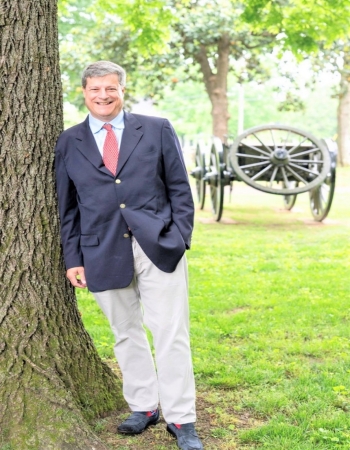From the Director

Dear Friends:
It has been the honor of my lifetime to serve the people of Tennessee as Executive Director and State Historic Preservation Officer of the Tennessee Historical Commission since 2007, and to have made a measurable impact for our conserving our state’s unique heritage. I will be leaving in November, and so as I close out my time here I want to reflect on some of the accomplishments over these past 18 ½ years.
Funding for preservation has been a key priority, and over $30 million has been allocated from two new grant programs established during my tenure — the Civil War Sites Preservation Fund (CWSPF) and the Historic Property/Land Acquisition Fund (HPLAF.) Last Fall, the Commission awarded $2 million to help restore 23 worthy preservation projects across the state from the HPLAF, and $6 million from it is helping fund capital improvements at our sites. The CWSPF has granted over $20 million to date and has helped save over 1,100 acres of hallowed battlefield grounds in rural places such as Shiloh as well as keeping greenspace in urban areas including Nashville, Murfreesboro, and Franklin. Places recently saved include the c. 1803 Brown’s Tavern in Chattanooga and the Salem Cemetery Battlefield in Madison County, which will be a new park for the area. The Tennessee Wars Commission (TWC) division of our office has led these efforts. In 2015, as part of my role with TWC the State acquired over 30 acres along the Elk River in Fayetteville and we partnered with the City and Friends and group to purchase Camp Blount and as a new park for the community. This is the site of the War of 1812-era encampment of Andrew Jackson and his Tennessee troops that helped result in our being known as the “Volunteer State.”
Our capacity has been strengthened through new programs and staff over the years, including a Cemetery Preservation Program established in 2019. We created a new State Historic Cemetery Register as an honorary recognition for Tennessee burial grounds. Our communications and outreach has been improved by having dedicated staff, and this full color newsletter is but one example of the achievements in this area.
During my time over $50,000,000 in capital project funding has benefited and transformed the THC State Historic Sites. The maintenance fund doubled during my time here, and our operating grants to the non-profits partners who operate the sites has increased several times. Since I started three new state historic sites were restored and opened to the public: the Hotel Halbrook in Dickson, Hawthorn Hill in Castalian Springs, and Sabine Hill in Elizabethton. We currently have four new visitor and event centers under construction that will position those sites to serve the public for the next few decades. In looking back at some of the most notable experiences at our sites, the February, 2008 tornado that hit Wynnewood in Sumner County stands out. I was closely involved with the restoration of this National Historic Landmark over the following four years. About a decade ago I led the acquisition of property next to the James K. Polk Home in Columbia formerly associated with the residence which today is once again part of the property and serves as a garden. The work to improve our sites continues. In White County, we’re completing the acquisition of 20 acres surrounding Sparta Rock House State Historic Site which will allow for new trails and the interpretation of the historic roadbed which passed near this former stagecoach inn and toll collection facility. The inn is also undergoing a comprehensive restoration.
On the Federal Programs side, Federal Historic Preservation Fund grants have made a measurable impact with survey, planning, and restoration grants. In just the past ten years alone, some $10 million in grants have funded over 450 worthy projects. During my time over $800,000,0000 in certified Federal Rehabilitation Historic Tax Credit projects have been administered by our office in conjunction with the National Park Service, including the Crosstown Concourse in Memphis which was Tennessee’s largest project to date. Our Certified Local Government Program now has 51 communities — up from 32 when I arrived — and all but a few of the municipalities in the state with historic zoning commissions are now enrolled. Approximately 40,000 Section 106 reviews have been completed since 2007. While the law allows for 30 days, the turnaround time for reviews in our office averages just two days.
These are just a few highlights. Everything I have noted is a reflection of hard work by our remarkable and talented team at the Tennessee Historical Commission, and I am grateful to have been a part of this dedicated staff, past and present. I also wish to thank the members of the Commission for their steadfast support and service over the years. Finally — and very importantly — my thanks to all of you across Tennessee and beyond who are interested in our history and in helping make sure our historic places continue to exist to enrich our communities and provide a sense of place in our ever-changing world. I will continue to serve the work of historic preservation, and I look forward to seeing you.
Sincerely,
Patrick
E. Patrick McIntyre, Jr.
Executive Director